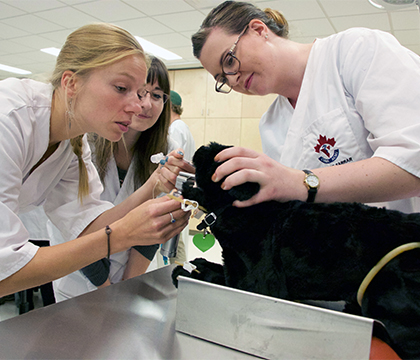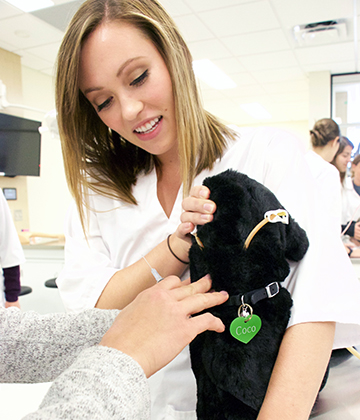
Trading tea towels for high-tech models
Veterinary medical education has relied on models for decades – but a new learning centre at the Western College of Veterinary Medicine (WCVM) will use the latest technology to make those models more realistic than ever.
By Jeanette NeufeldWorkers recently completed construction on the new BJ Hughes Centre for Clinical Learning at the veterinary college. This customized classroom was made possible by a major donation from Bev Hughes, who saw a need for the facility when she toured the human medicine-focused Clinical Learning Resource Centre in the University of Saskatchewan's Health Sciences building.
"It is advanced learning. I think any advanced learning is good. More importantly, it is 21st century learning and 21st century technology. I want our vet college in Saskatoon to be the most progressive in North America," says Hughes, who along with the BJ Hughes Foundation, contributed $340,000 toward the centre that cost nearly $500,000 to build and equip.
During the official opening of the centre on Sept. 22, Hughes announced an additional $250,000 donation, which will be used to ensure sustainability of the clinical learning centre.
Hughes, who has supported the college for more than 10 years through a scholarship, says her dedication stems from her passion for animals and her love for the WCVM and the work done at the college.
The new classroom will give students a chance to practise clinical techniques and hone their skills in a safe learning environment. The lab's flexible learning space will offer the college's faculty the opportunity to teach various levels of simulation – from running through client scenarios with actors to practising surgical techniques on computerized models.
"The use of clinical simulation has exploded in human medicine, and veterinary medicine has really been following this trend. The development of this new centre will place the WCVM at the forefront of these developing technologies and give our students the best learning experience possible," says Dr. Douglas Freeman, WCVM dean.
"We are so thankful for the vision and drive of Bev Hughes, whose gift has put ideas into action at the WCVM."

In the past, current faculty learned on simple models, such as suturing straight lines on plaid tea towels. While this is still an effective way of practicing stitching skills, today's models and task trainers are much more realistic and advanced. Using models students can practice skills and learn techniques such as placing IV catheters or administration of fluids and general anesthesia. These new tools allow students to repeat important skills until they become proficient.
"Repetition is really what drives confidence and competence. You can't practise multiple times on an animal – that would be inhumane. But on the models, you can practise as many times as it takes," says Dr. Chris Clark, the WCVM's associate dean, academic.
Students eventually complete procedures on live animals, but the chance to break down and fine tune skills allows them to build confidence as they move through their training.
Research in human medicine has shown that these types of virtual learning environments are an effective way for students to learn, and WCVM faculty and staff were eager to implement these new methods of veterinary teaching into the curriculum. While planning for the centre began more than five years ago, Hughes' donation moved things forward in the past 18 months.
"Without this donation, we wouldn't have the space," says Clark, adding that the new technologies required a room with specific requirements. The college now has an "incredibly inviting" room that everyone is excited to use.
Clark says students will have 24-hour access to the facility so they can practise skills on their own, outside of class time.
"We are incredibly grateful," says Clark of Hughes' gift. "It was her vision that really drove this along."
